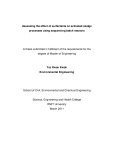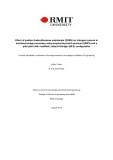
Anionic surfactant
-
Anionic and non-ionic surfactants have been detected in the influents to and effluents from wastewater treatment plants (WWTPs). Linear alkylbenzene sulphonates (LAS) and alkylphenol ethoxylates (APEO) are the most frequently detected anionic and non-ionic surfactants in urban wastewater. The aim of this study was to assess the effect of the presence of anionic and non-ionic surfactants in the influent to WWTPs on activated sludge processes.
 111p
111p  runthenight05
runthenight05
 01-03-2023
01-03-2023
 9
9
 3
3
 Download
Download
-
Municipal wastewater treatment plants generally utilise biological activated sludge processes to remove organic compounds and nitrogen. The biological nitrogen removal (BNR) occurs in two steps, nitrification (ammonium removal) and denitrification (nitrates removal). This study focused on a medium-sized wastewater treatment plant (WTP) which experienced poor nitrification for years, mainly when the weather temperature drops.
 125p
125p  runthenight07
runthenight07
 01-03-2023
01-03-2023
 12
12
 3
3
 Download
Download
-
Tuyển tập các báo cáo nghiên cứu về lâm nghiệp được đăng trên tạp chí lâm nghiệp Original article đề tài:"Ecophysiological responses of Mediterranean pines to simulated sea aerosol polluted with an anionic surfactant: prospects for biomonitoring"
 10p
10p  toshiba5
toshiba5
 19-09-2011
19-09-2011
 57
57
 4
4
 Download
Download
CHỦ ĐỀ BẠN MUỐN TÌM















